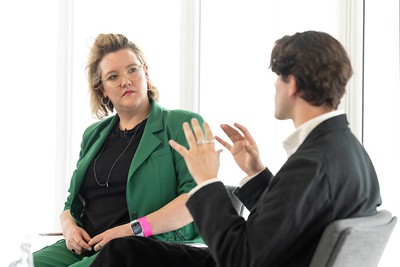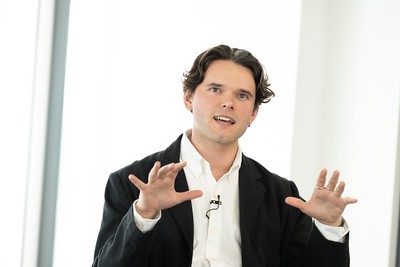This year, a research paper went pretty viral on TikTok. It was seen by nearly a quarter of a million people and it was based on the University of Oxford’s Wellbeing Research Centre work into mental health interventions in the workplace.
The key finding of the research was not too surprising: there is no evidence that individual interventions, like wellbeing apps and relaxation classes, improves employee’s mental health. It is organisational change which makes the difference.
This holds true for general workplaces. But what about newsrooms? The mental health conversation may have come a long way in the industry, but these are workplaces with a long history of macho environments, managers without managerial training and journalists reluctant to accept help in fear of limiting their career prospects.
Hot on this issue is Isabelle Roughol, an independent media consultant who regularly writes about (mis)management in the media, based on a career with vast experience in both tech companies and newsrooms.
At Newsrewired last week (22 May 2024), she interviewed author of the research paper Dr William Fleming about applying his findings to the news industry. Below is an edited version of the interview.
Isabelle Roughol (IR): What did you find out in your study?
William Fleming (WF): It was looking at all the types of initiatives that large organisations implement in workplaces to improve mental health and wellbeing. Around 70 per cent of UK organisations implement some strategy programme aimed at improving the wellbeing of their workforce, but the evidence of its effectiveness is definitely up for debate. I was looking specifically at what we call individual-level, universal mental health programmes, so applicable to everybody. This would be like mindfulness programmes, resilience and stress training, time management, corporate volunteering – which is slightly different, but we can still classify along these lines – wellbeing apps, too.
We evaluated whether the people who engaged with these practices saw improved mental health as a result. The findings were pretty negative: there was no difference between those who engage in these practices and those who do not, which is a bit of an alarm bell for a lot of popular strategies for trying to improve wellbeing and stress at work.
IR: Do you have a sense of why these strategies did not work?
There is an imbalance between the demands of the job and the resources given. This is what creates harm and stress, and it becomes unmanageable for people. If interventions are not targeting the demands that are placed on people, they will not see a change in wellbeing.
William Fleming
IR: I wrote an article a few years ago precisely about this: when I am burning out, the last thing I want is a subscription to Headspace. I am glad that science seems to square that. So what is it then that does work, if not, these individual interventions?
WF: It is not really surprising: good management, role clarity, having the right skills and colleagues to do the job, being paid properly. Stress comes from not being adequately supported or developed. This is where we should be targeting action, improving; general people management, people’s capabilities, feedback systems that inform performance review systems, workflows and strategies. There is a real sound basis for these strategies.
IR: This is not something we see a lot of, especially in the current economic climate, having enough people to do the work, career progression ladders, or even managers who are trained to be managers, as opposed to being plucked out of the ranks of the reporters and suddenly made a people manager.

I have experienced one really happy, high-functioning work culture in my career so far, and that was not in a newsroom. It was in tech. A major difference, to be honest, is that there was a lot of money floating around. And that money afforded time for training and rewarding people. How do you have happy and supported staff without tech money?
WF: That is the big challenge. In practice, it means promoting people with the social skills to be effective managers and question existing practices – like feeding the beast that is news. Maybe the beast is not quite as hungry as you think is. It obviously is for breaking news environments. But maybe that culture does not need to be replicated in less urgent environments.
As for leaders, make a point to disconnect from work and silence notifications. Develop peer- and colleague support networks. People do this informally, but it can be formal as well within organisations. But have people that you can complain to, bounce ideas off and develop collective responses to.
IR: Possibly the most effective free intervention when I was a busy team manager for a global team was to have a strict practice of no Slack or email notifications on phones. My message to the team was: I am always available for you, but call. It is crazy how I got maybe one call a year. People realise that pseudo-emergencies are exactly that.
WF: A lot of urgency is artificial, it does not necessarily need to be there. If there are policies and principles in place that you can just question if this needs to happen right now, the answer is probably not.

IR: But we are very much a deadline-driven profession. If you look at a newsroom today, it is still very much about the work and very little about the worker. Are we unique in that sense?
WF: Lots of professions have a sense of social purpose and commitment to the job, like the police force or healthcare. And in these contexts, where it is more life and death than journalism, they are able to reflect on their workloads. These other industries are also going through a reckoning about how to deal with these problems. Journalism is maybe a special industry, but not unique.
IR: You say it is not quite life and death, but making sure the newspaper goes out tomorrow feels like life and death. Just as with healthcare professions, non-profits, and maybe academia as well, people go into journalism based on values. And that can be a bit of a trap because it becomes your identity, right?
WF: Yes, there is a very good title of a book that came out recently, called Work Won’t Love You Back. You cannot let yourself be exploited by your vocation, because ultimately, you will not be able to keep doing it, as the quality will decline.
I used to work in the UK Cabinet Office and some of my colleagues were in Foreign Office embassies. If you worked in highly stressful environments, maybe it is war-torn, or there has been a natural disaster, you get periods of sabbaticals after you have been in these highly stressful areas.
“Maybe it does not need to be sabbaticals, maybe that is not realistic for resource-constrained environments, but you can think in terms of rotations, which also develops additional skills in wider, supportive roles.”
William Fleming
We see this in call centres with angry customers who are passed onto firefighting teams, and who is in that team gets rotated around. So you are not always dealing with angry customers. I hope some of these ideas might be translatable for newsrooms.
IR: It is quite existential for us as an industry to think about how we retain talent and keep them happy and well-performing for the long run. You cannot just keep exhausting 20-year-olds and then by the time they are 35, they leave and we have to train a whole new crop of journalists again.
Audience: If initiatives such as mental health apps, and there are no resources for other interventions, like better pay. What is the solution? What do we do?
WF: This does not sound very sexy, but it is work redesign. Understand what the job is, what the demands are, what the tasks are that everybody needs to do. Work through this with the individuals and the managers, and then try and come up with solutions along the way, which are very specific to the problems.
Often the biggest stress will be about bad management. But there are specific aspects of that, such as improving feedback or the channels to ask for help. That does not cost any money, that is just about trying to improve the relationships and the support structures.
IR: There are definitely things that do not require money, although time is money when you are a manager. Look beyond the the next deadline. Do you have career ladders? Do people know where they are going?
I discovered weekly one-on-ones with my manager when I left a newsroom. Are there processes for clean escalation of conflict? Those were foreign words to me until I worked outside the newsroom. And those build structures for healthy culture.
Isabelle Roughol
I know there is not a lot of money. We need to stop thinking about our people as an optional expense. Having a budget for raises every year is not optional. It is a part of running a business. And if you do not have it, there is an issue with how your business is being run and you have to look at your budget again.
Audience: I just want to say thank you as somebody who worked in the dark ages of the newsroom. It is not so much the work, which I do because I love it, it is just the treatment; the rough-housing on the news desk. How much uptake is there in the industry for what you are advocating?
IR: I do not think this was something that we were talking about even a few years ago. I write a newsletter which is about exactly these topics and whenever I write about something like this, my inbox is absolutely flooded with “Oh my god, this is exactly my experience, thank you for talking about this.” And then I get a bunch of incoming requests from newsroom leaders and executives being like, “Hey, could you consult with us? Could you help us out?” Which usually ends up in a conversation with “We have no money, but we really want you to work for us.” So there is interest, but not commitment yet.
Audience: No journalist ever won an award because they missed a story because they took a wellbeing walk, or they had a day off. How can the industry do better at recognising journalists who are prioritising the wellbeing of themselves and their staff?
WF: Recognition at work is one of the core drivers of job satisfaction. So for journalists, that recognition usually comes externally, like through bylines or awards, but recognition can also happen internally.
Recognition schemes exist in most large organisations all over the world. That can be on an individual basis; there are slightly gimmicky “bravo” strategies, like ’employee of the week ‘. But it can also be on a team basis, in the same process of celebrating when a whole team is able to deliver a great story or a great product, or they have managed to adapt or shift gears on a project.
IR: We should get over words a little bit. My last post was called ‘Journalism’s largest exit interview’, and I just tried to curate every post I could find from a journalist explaining why they were leaving the industry, and one that showed up a lot is recognition. Because the only way that we know how to recognise people is through awards and bylines, and that makes it look like journalism is an individual sport. I am a big believer in journalism as a team sport.
I saw a lot of comments from people, particularly in audience, product and editing roles – which is not even credited in most newsrooms for some weird reason – who said: “We have no career progression, and we are invisible. And we’re also paid crap. And we don’t even have a byline to show for it.”
Those are the first ones to leave your newsroom and they are indispensable to the work that we do. So reworking recognition to be a little bit less star-driven in this industry would be quite nice.


